
应用化学 ›› 2022, Vol. 39 ›› Issue (3): 374-390.DOI: 10.19894/j.issn.1000-0518.210108
基于适配体和抗体的生物传感器在雌二醇检测中的应用
- 1.上海理工大学医疗器械与食品学院,上海 200093
2.军事科学院军事医学研究院,环境医学与作业医学研究所,天津市环境与食品安全风险监控技术重点实验室,天津 300050
-
收稿日期:2021-03-11接受日期:2021-06-26出版日期:2022-03-01发布日期:2022-03-15 -
通讯作者:刘宝林,高志贤 -
基金资助:国家自然科学基金(81773482)
Application of Biosensors Based on Aptamers and Antibodies in the Detection of Estradiol
Tao WANG1,2, Sha LIU2, Bao-Lin LIU1( ), Zhi-Xian GAO2(
), Zhi-Xian GAO2( )
)
- 1.School of Medical Devices and Food,University of Shanghai for Science and Technology,Shanghai 200093,China
2.Institute of Environmental Medicine and Operational Medicine,Academy of Military Medicine,Academy of Military Sciences,Tianjin Key Laboratory of Environmental and Food Safety Risk Monitoring Technology,Tianjin 300050,China
-
Received:2021-03-11Accepted:2021-06-26Published:2022-03-01Online:2022-03-15 -
Contact:Bao-Lin LIU,Zhi-Xian GAO -
About author:blliuk@163.com; gaozhx@163.com
-
Supported by:the National Natural Science Foundation of China(81773482)
摘要:
雌二醇(Estradiol,E2)是一种主要的环境雌激素,具有作用强、危害广等特征,可扰乱人体及动物体的正常内分泌功能,从而产生不利影响,因此E2的快速、准确检测对于食品安全和公共卫生至关重要。传统的检测方法主要是基于大型仪器分析,这些方法具有高灵敏度、准确性的同时也存在操作繁琐、成本较高、仅限于在实验室内进行等缺陷。近年来,研究人员开发了多种生物传感器对E2进行检测,前期的生物传感器出现灵敏度低、存在干扰信号等问题,还有很大的改进空间。而基于适配体和抗体的生物传感器具有特异性好、灵敏度高、操作简单、响应快速、易用于现场检测等优势,已广泛应用于食品中E2的检测分析。本文在对适配体和抗体的特点简要介绍的基础上,综述了以适配体和抗体为识别信号的多种生物传感器在E2检测中的最新研究进展,并对其未来研究方向做出了展望。
中图分类号:
引用本文
王涛, 刘厦, 刘宝林, 高志贤. 基于适配体和抗体的生物传感器在雌二醇检测中的应用[J]. 应用化学, 2022, 39(3): 374-390.
Tao WANG, Sha LIU, Bao-Lin LIU, Zhi-Xian GAO. Application of Biosensors Based on Aptamers and Antibodies in the Detection of Estradiol[J]. Chinese Journal of Applied Chemistry, 2022, 39(3): 374-390.
使用本文
特点 Feature | 核酸适配体 Aptamer | 抗体 Antibody |
|---|---|---|
免疫原性 Immunogenicity 生产成本 Production cost 生产时间 Production time 生产方式 Production styles 批间差异 Difference between batch 结合方式 Combination method 热/化学稳定性 Thermal/chemical stability 亲和力/特异性 Affinity/specificity | 无/低 Low 低 Low 数小时 A few hours 固相合成技术 Solid phase synthesis 差异小,产品均一性高 Small difference, high homogeneity 碱基互补配对、氢键、静电相互作用 Base complementary pairing, hydrogen bonding, electrostatic interaction 高 High 高(Kd在pmol~nmol) High(Kd在pmol~nmol) | 高 High 高 High 数天至数月 A few days to months 哺乳动物细胞系统 Mammalian system 差异大 Big difference 与抗原特异性结合 Antigen and antibody specific binding 不稳定,易发生不可逆变性 Unstable, prone to irreversibility 高(Kd在pmol~nmol) High(Kd在pmol~nmol) |
修饰难易程度 Degree of modification | 容易修饰或偶联功能基团 Easily | 修饰困难 Difficultly |
可识别靶点 Recognizable target | 广泛,可识别离子、多肽、小分子化合物、蛋白质、核酸、病毒、细菌、细胞和组织等 Wide, can identify ions, peptides, small molecule compounds, proteins, nucleic acids, viruses, bacteria, cells and tissues, etc. | 仅识别具有免疫原理的靶点 Only identify targets with immune principles |
表1 适配体和抗体的特性
Table 1 Characteristics of aptamers and antibodies
特点 Feature | 核酸适配体 Aptamer | 抗体 Antibody |
|---|---|---|
免疫原性 Immunogenicity 生产成本 Production cost 生产时间 Production time 生产方式 Production styles 批间差异 Difference between batch 结合方式 Combination method 热/化学稳定性 Thermal/chemical stability 亲和力/特异性 Affinity/specificity | 无/低 Low 低 Low 数小时 A few hours 固相合成技术 Solid phase synthesis 差异小,产品均一性高 Small difference, high homogeneity 碱基互补配对、氢键、静电相互作用 Base complementary pairing, hydrogen bonding, electrostatic interaction 高 High 高(Kd在pmol~nmol) High(Kd在pmol~nmol) | 高 High 高 High 数天至数月 A few days to months 哺乳动物细胞系统 Mammalian system 差异大 Big difference 与抗原特异性结合 Antigen and antibody specific binding 不稳定,易发生不可逆变性 Unstable, prone to irreversibility 高(Kd在pmol~nmol) High(Kd在pmol~nmol) |
修饰难易程度 Degree of modification | 容易修饰或偶联功能基团 Easily | 修饰困难 Difficultly |
可识别靶点 Recognizable target | 广泛,可识别离子、多肽、小分子化合物、蛋白质、核酸、病毒、细菌、细胞和组织等 Wide, can identify ions, peptides, small molecule compounds, proteins, nucleic acids, viruses, bacteria, cells and tissues, etc. | 仅识别具有免疫原理的靶点 Only identify targets with immune principles |
传感器类型 Sensors type | 检测体系 Detection system | 线性范围 Linear range | 检出限 Limit of detection | 实际样品 Real sample | 参考文献 References |
|---|---|---|---|---|---|
基于荧光的生物传感器 Biosensor based on fluorescence | FAM-BHQ1 | 0.1~10 μg/mL | 0.1 ng/mL | Milk | [ |
| AuNPs/Rho B | 0.48~200 nmol/L | 0.48 nmol/L | Water | [ | |
| FAM/GN | 0~20 ng/mL | 1.02 ng/mL | Water | [ | |
| EXPAR-HCR | 0.4~800 pg/mL | 0.37 pg/mL | Milk, Water | [ | |
| Ru-QDs | 0.08~0.4 μmol/L | 37 nmol/L | FBS | [ | |
| 基于金纳米比色的生物传感器Biosensor based on gold nanometer colorimetry | AuNPs | 0.5~0.8 nmol/L 0.3~0.9 nmol/L | 0.183 nmol/L 0.185 nmol/L | Milk Egg | [ |
| PDDA/AuNPs | 1.57~350 nmol/L | Water | [ | ||
| 基于表面增强拉曼散射的生物传感器Biosensor based on surface?enhanced raman scattering | Au@Ag CS NPs-MBA | 0.01~50 nmol/L | 5 pmol/L | Water | [ |
| Au@Ag CS NPs-Cy3 | 1×10-13 ~ 1×10-9 mol/L | 0.748 pg/L | Water | [ | |
| 基于电化学发光的生物传感器Biosensor based on electrochemiluminescence | Ru(bpy)32+ | 0.01~10 nmol/L | 1.1×10-12 mol/L | Serum, Tap water | [ |
| α-FeOOH@CdS-AgNCs-DNA | 0.01~10 pg/mL | 0.003 pg/mL | Serum | [ | |
基于电化学的生物传感器 Electrochemical?based biosensor | MoS2/GNPs-GNPs/THI | 1.0×10-14 ~ 5.0×10-12 mol/L | 4.2×10-15 mol/L | Water | [ |
| Apt-G/MCH-Au/ DNase I | 0.019~2.7 ng/L | 0.014 ng/L | Water | [ | |
| CDs/SPCE | 1.0×10-7 ~ 1.0×10-12 mol/L | 0.5×10-12 mol/L | Water | [ |
表2 基于适配体的生物传感器在E2检测中的应用
Table 2 Application of aptamer?based biosensors in E2 detection
传感器类型 Sensors type | 检测体系 Detection system | 线性范围 Linear range | 检出限 Limit of detection | 实际样品 Real sample | 参考文献 References |
|---|---|---|---|---|---|
基于荧光的生物传感器 Biosensor based on fluorescence | FAM-BHQ1 | 0.1~10 μg/mL | 0.1 ng/mL | Milk | [ |
| AuNPs/Rho B | 0.48~200 nmol/L | 0.48 nmol/L | Water | [ | |
| FAM/GN | 0~20 ng/mL | 1.02 ng/mL | Water | [ | |
| EXPAR-HCR | 0.4~800 pg/mL | 0.37 pg/mL | Milk, Water | [ | |
| Ru-QDs | 0.08~0.4 μmol/L | 37 nmol/L | FBS | [ | |
| 基于金纳米比色的生物传感器Biosensor based on gold nanometer colorimetry | AuNPs | 0.5~0.8 nmol/L 0.3~0.9 nmol/L | 0.183 nmol/L 0.185 nmol/L | Milk Egg | [ |
| PDDA/AuNPs | 1.57~350 nmol/L | Water | [ | ||
| 基于表面增强拉曼散射的生物传感器Biosensor based on surface?enhanced raman scattering | Au@Ag CS NPs-MBA | 0.01~50 nmol/L | 5 pmol/L | Water | [ |
| Au@Ag CS NPs-Cy3 | 1×10-13 ~ 1×10-9 mol/L | 0.748 pg/L | Water | [ | |
| 基于电化学发光的生物传感器Biosensor based on electrochemiluminescence | Ru(bpy)32+ | 0.01~10 nmol/L | 1.1×10-12 mol/L | Serum, Tap water | [ |
| α-FeOOH@CdS-AgNCs-DNA | 0.01~10 pg/mL | 0.003 pg/mL | Serum | [ | |
基于电化学的生物传感器 Electrochemical?based biosensor | MoS2/GNPs-GNPs/THI | 1.0×10-14 ~ 5.0×10-12 mol/L | 4.2×10-15 mol/L | Water | [ |
| Apt-G/MCH-Au/ DNase I | 0.019~2.7 ng/L | 0.014 ng/L | Water | [ | |
| CDs/SPCE | 1.0×10-7 ~ 1.0×10-12 mol/L | 0.5×10-12 mol/L | Water | [ |
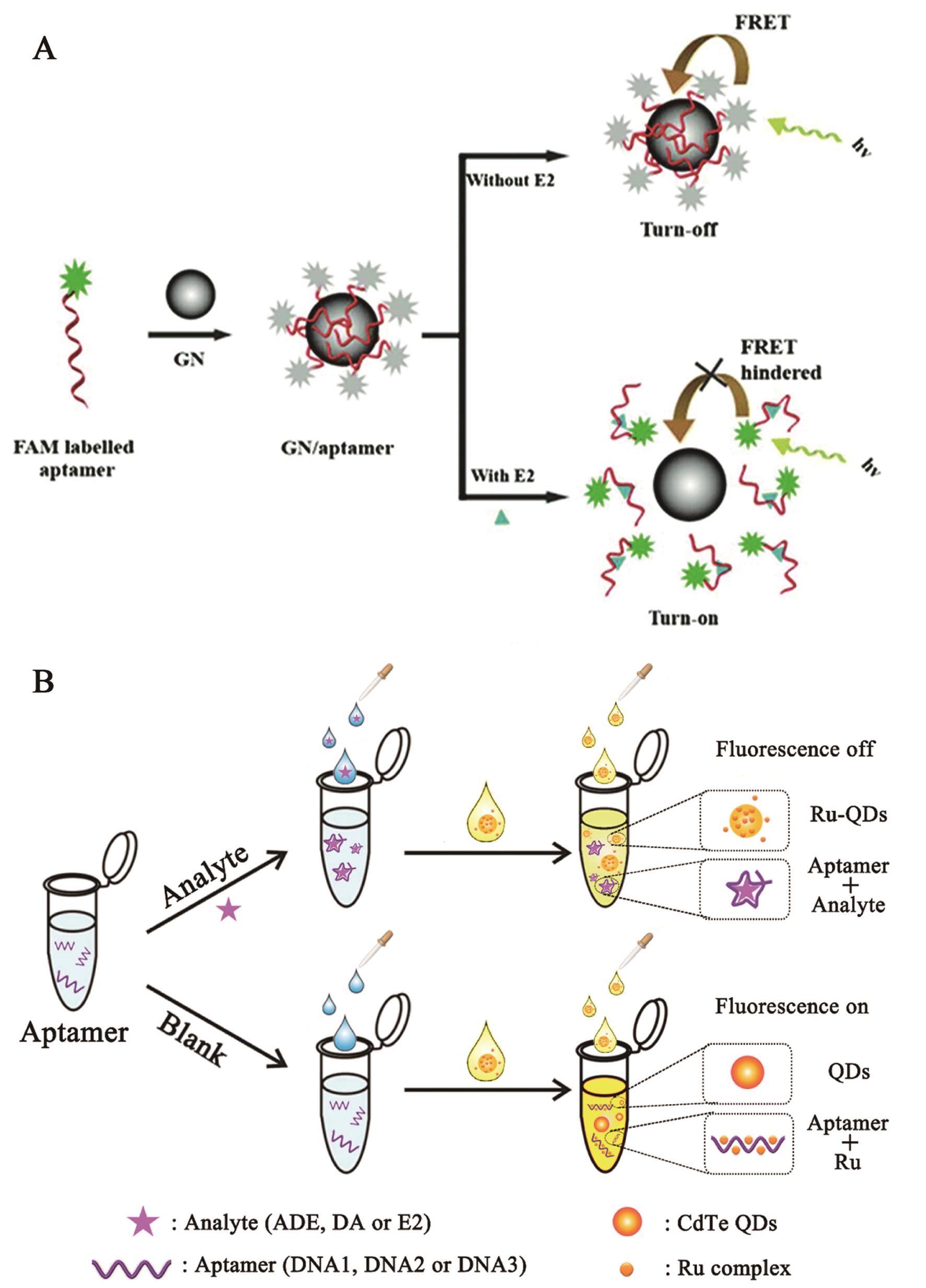
图 1 基于适配体的荧光生物传感器的示意图: (A)基于截短适配体和石墨纳米粒子的荧光生物传感器用于E2检测[12];(B)基于Ru络合物和量子点的无标记荧光适配体传感器用于检测腺苷、多巴胺和E2[33]
Fig.1 Schematic diagram of aptamer-based fluorescent biosensors:(A)A fluorescence biosensor based on shortened aptamer sequence and graphite for E2 detection[12];(B)A universal label-free fluorescent aptasensor based on Ru complex and quantum dots for adenosine, dopamine and E2 detection[33]
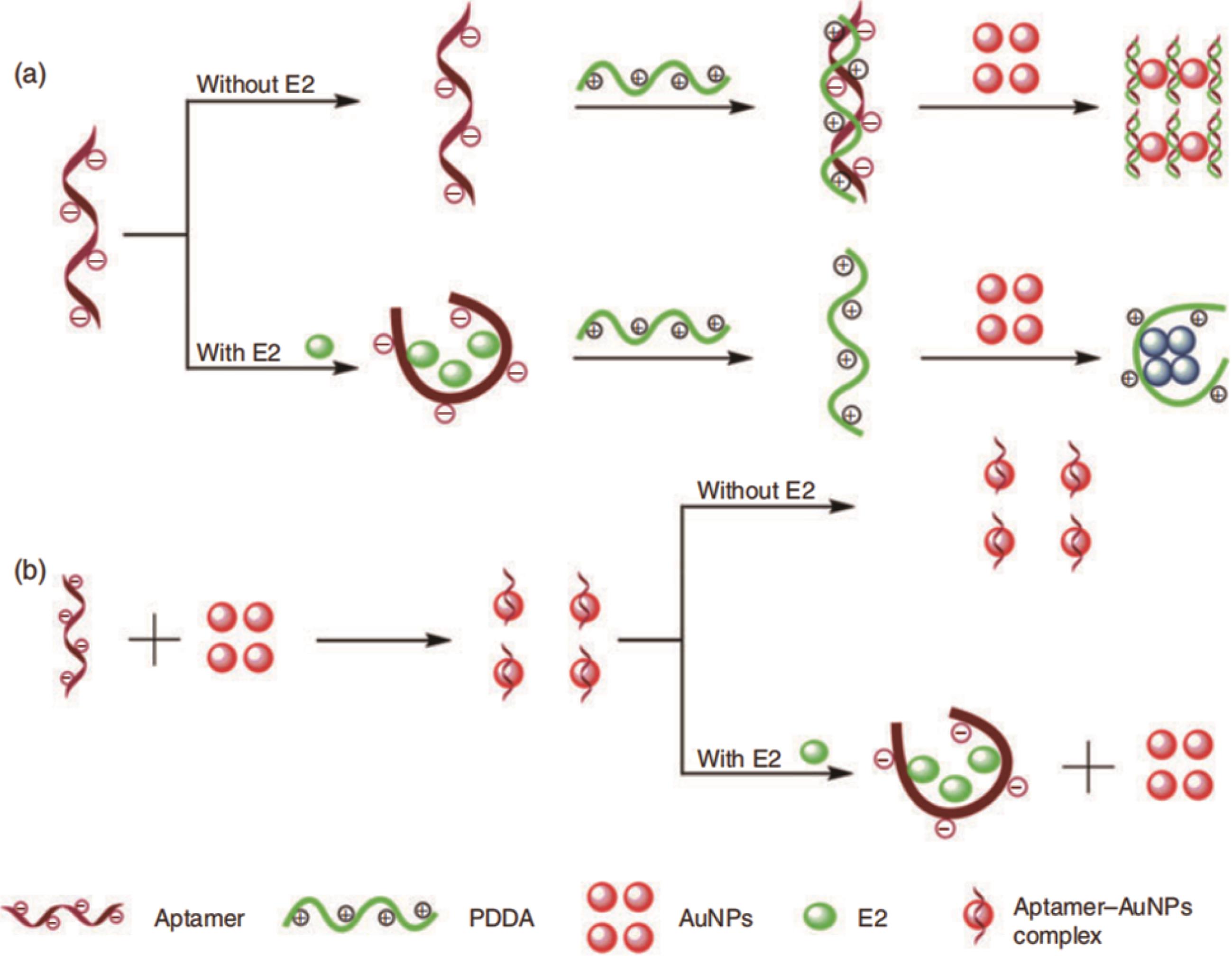
图2 基于PDDA诱导AuNPs聚集的无标记生物传感器用于E2检测的示意图[39]
Fig.2 Schematic description of the label-free biosensor for E2 detection based on the aggregation of AuNPs induced by PDDA[39]
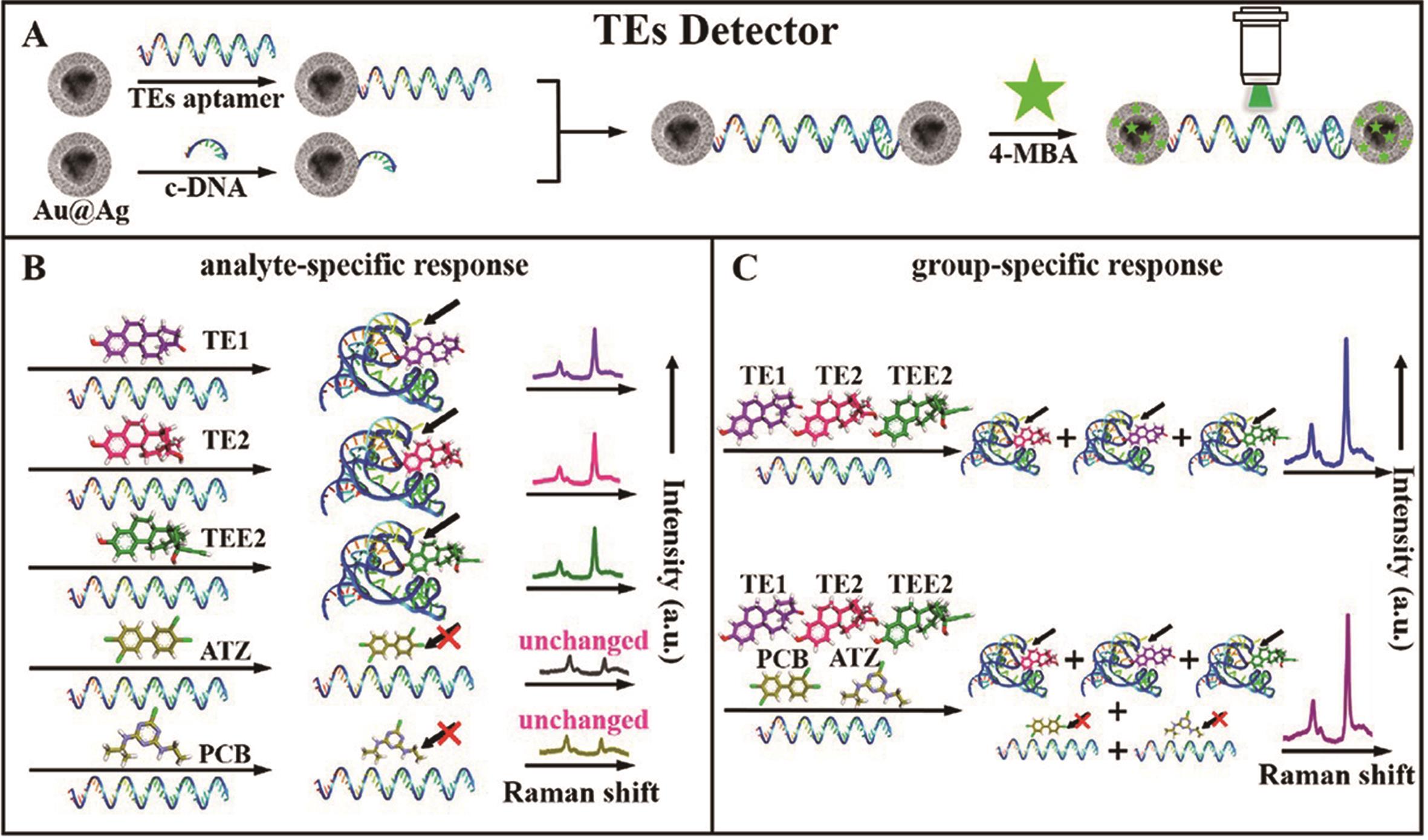
图3 基于Au@Ag CS NPs和适配体的SERS方法用于检测TEs的示意图[43]: (A)TEs检测器的构建过程[43];(B)特异性分析目标物的过程[43];(C)特异性分析组目标物的过程[43]
Fig.3 Schematic diagram of the SERS spectra based on Au@Ag CS NPs and aptamers for detecting TEs[43]:(A)Construction process of TEs detector[43];(B)The process of detecting analyte-specific targets[43];(C)The process of detecting group-specific targets[43]
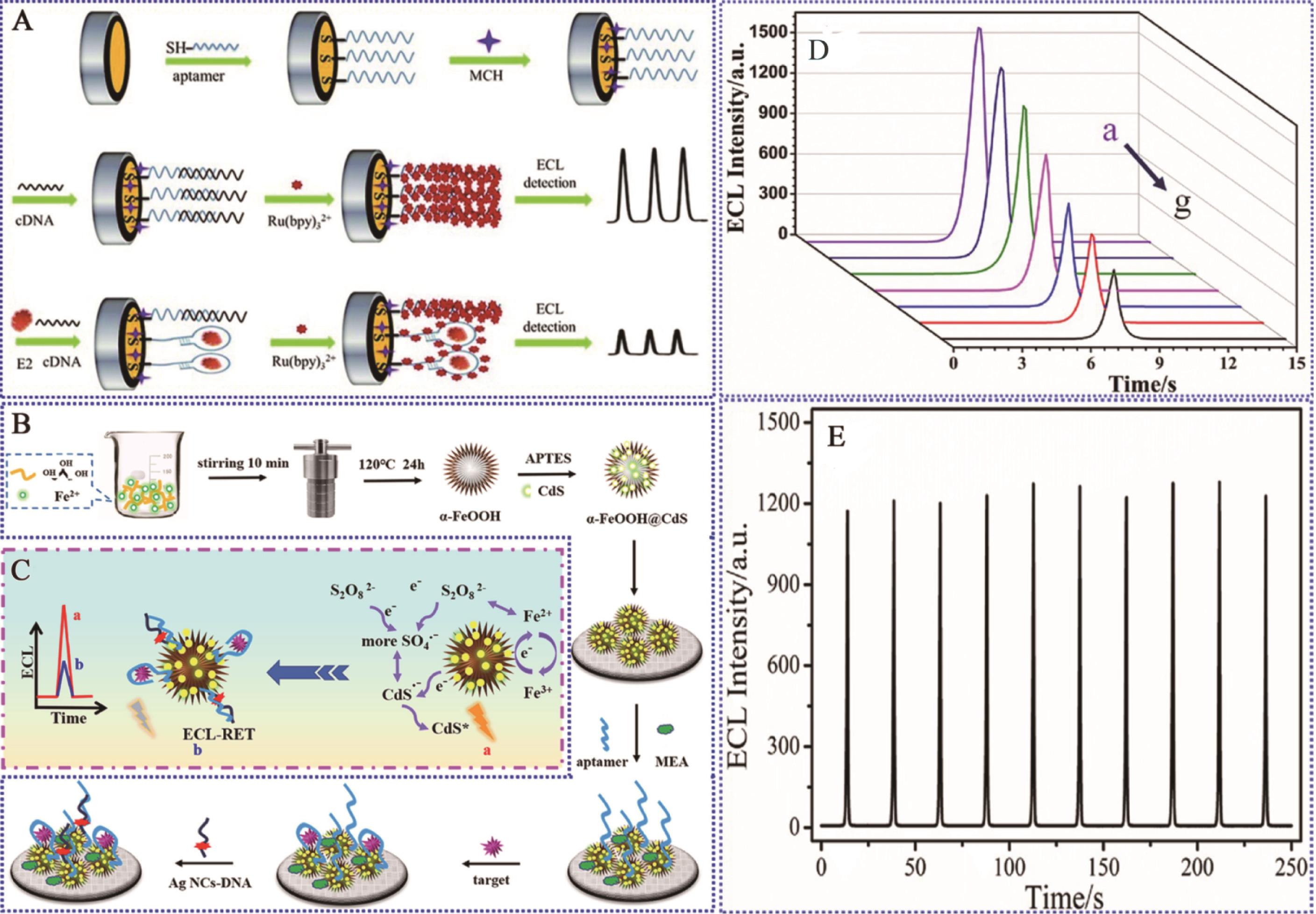
图4 基于适配体的ECL生物传感器:(A)基于竞争性检测和cDNA扩增的无标记灵敏ECL传感器用于测定E2的示意图[49];(B)基于α-FeOOH@CdS/AgNCS共振能量转移的ECL传感器用于E2检测的示意图[50];(C)ECL信号产生、增强、淬灭机制示意图[50];(D)分析不同浓度E2的ECL性能,从a到g:10、5、1、0.5、0.1、0.05、0.01 pg/mL[50];(E)浓度为1 pg/mL的E2在循环周期的ECL响应[50]
Fig.4 Aptamer-based Electrochemiluminescence:(A)Label-free and sensitive electrochemiluminescence aptasensor for the determination of estradiol based on a competitive assay with cDNA amplification[49];(B)An electrochemiluminescence sensor for 17β-estradiol detection based on resonance energy transfer in α-FeOOH@CdS/Ag NCs[50];(C)Proposed mechanism for ECL signal generation, enhancement, and quenching[50];(D)ECL performance of the constructed sensor for different E2 detection, from a to g: 10, 5, 1, 0.5, 0.1, 0.05, 0.01 pg/mL[50];(E)Time-based ECL responses of the ECL sensor under several cycles for detection of 1 pg/mL E2[50]
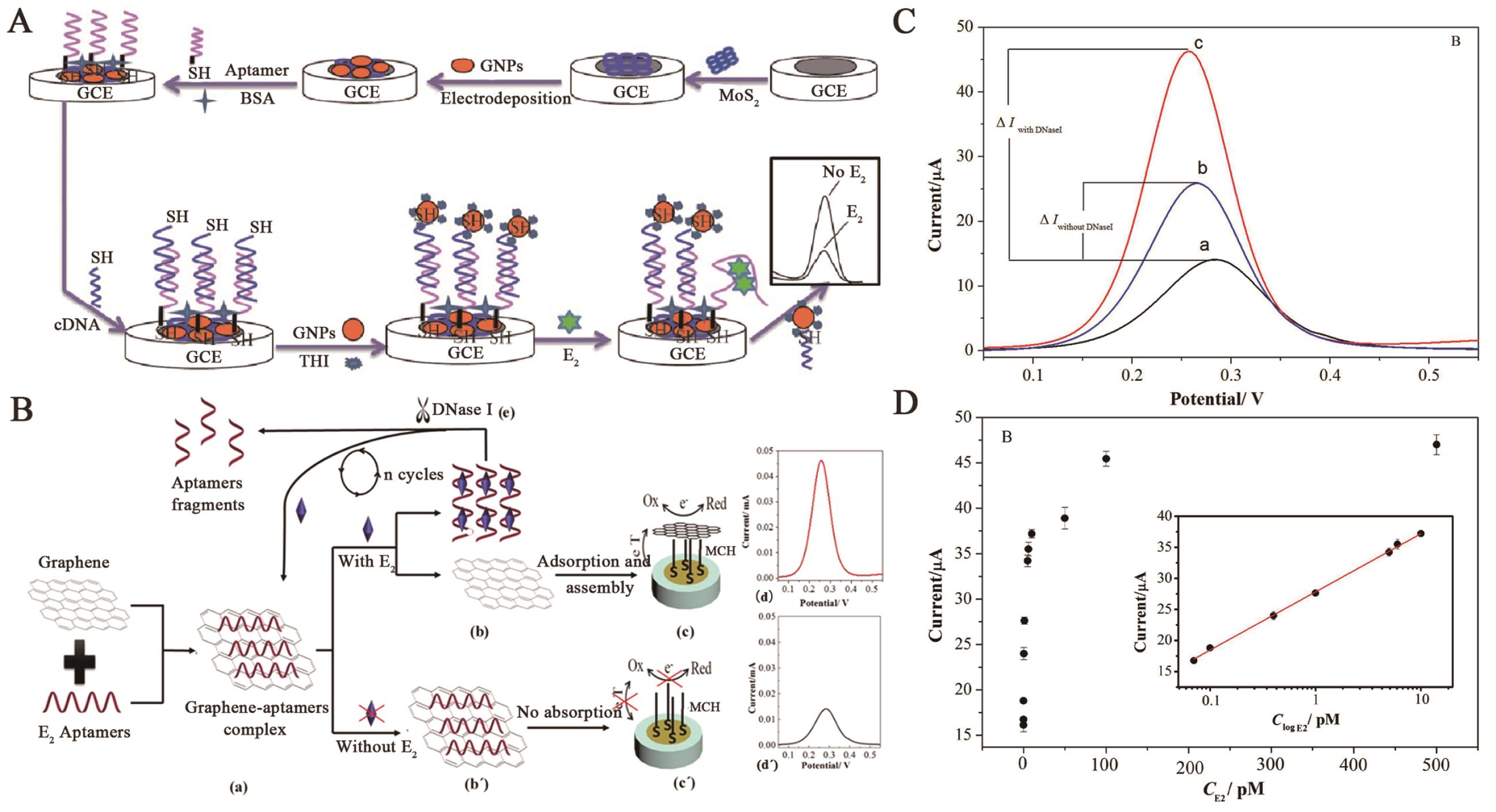
图5 基于适配体的电化学生物传感器:(A)基于二硫化钼/金纳米和硫堇/金纳米信号放大的E2电化学适配体传感器[55];(B)基于双功能石墨烯信号放大的超灵敏E2电化学无标签传感器[56];(C)a b c分别指Au/MCH、无DNase I、加入100 U/mL DNase I的电化学响应[56];(D)与E2浓度对应的ΔI曲线,内含ΔI与E2浓度对数的线性关系[56]
Fig.5 Aptamer-based electrochemical biosensor:(A)Electrochemical aptasensor based on signal amplification of molybdenum disulfide/gold nanoparticles and thionine/nanoparticles[55];(B)A supersensitive electrochemical label-free aptasensor of estradiol based on signal amplification of bi-functional graphene [56];(C)DPV of MCH/Au before (a) and after (b,c) incubated with 0.1 nmol/L E2 without (b) or with 100 U/mL DNase I (c) [56]; (D)The curve of ΔI corresponding to the concentrations of E2. Inset: the linear relationship between ΔI and the logarithm of E2 concentration[56]
传感器类型 Sensors type | 检测体系 Detection system | 线性范围 Linear range | 检出限 Limit of detection | 实际样品 Real sample | 参考文献 References |
|---|---|---|---|---|---|
基于荧光的生物传感器 Biosensor based on fluorescence | 平面波导型倏逝波 Paper microzone-PVA+SBA | 0.08~2.52 μg/L 0~100 ng/L | 0.05 μg/L 0.05 ng/L | Water Water | [ [ |
基于金纳米比色的生物传感器 Biosensor based on gold nanometer colorimetry | AuNPs | 3~105 pg/mL | 3 pg/mL | Water | [ |
基于表面增强拉曼散射的生物传感器 Biosensor based on surface-enhanced raman scattering | SERS nano-tags | 0.1~1000 pg/mL | 0.65 pg/mL | Serum | [ |
基于电化学发光的生物传感器 Biosensor based on electrochemiluminescence | Fe3O4@Au-CdS QD | 2.0×10-10~ 2.0×10-4 mg/mL | 3.2×10-12 mg/mL | Veterinary drug residues | [ |
基于电化学的生物传感器 Biosensor based on electrochemical | Au@Pd-CoFe2O4/rGO | 0.01~18.0 ng/mL | 3.3 pg/mL | Water | [ |
| Fe3O4-NH2/SWASV/EIS | 0.05~100000 pg/mL | 0.015 pg/mL | Water | [ | |
基于光电化学的生物传感器 Biosensor based on photoelectrochemistry | ZnIn2S4@NH2-MIL-125(Ti) | 0.0005~20 ng/mL | 0.3 pg/mL | Water | [ |
| TiO2-CdS | 5~4000 pg/mL | 2 pg/mL | Water | [ |
表3 基于抗体的生物传感器在E2检测中的应用
Table 3 Application of antibody?based biosensors in E2 detection
传感器类型 Sensors type | 检测体系 Detection system | 线性范围 Linear range | 检出限 Limit of detection | 实际样品 Real sample | 参考文献 References |
|---|---|---|---|---|---|
基于荧光的生物传感器 Biosensor based on fluorescence | 平面波导型倏逝波 Paper microzone-PVA+SBA | 0.08~2.52 μg/L 0~100 ng/L | 0.05 μg/L 0.05 ng/L | Water Water | [ [ |
基于金纳米比色的生物传感器 Biosensor based on gold nanometer colorimetry | AuNPs | 3~105 pg/mL | 3 pg/mL | Water | [ |
基于表面增强拉曼散射的生物传感器 Biosensor based on surface-enhanced raman scattering | SERS nano-tags | 0.1~1000 pg/mL | 0.65 pg/mL | Serum | [ |
基于电化学发光的生物传感器 Biosensor based on electrochemiluminescence | Fe3O4@Au-CdS QD | 2.0×10-10~ 2.0×10-4 mg/mL | 3.2×10-12 mg/mL | Veterinary drug residues | [ |
基于电化学的生物传感器 Biosensor based on electrochemical | Au@Pd-CoFe2O4/rGO | 0.01~18.0 ng/mL | 3.3 pg/mL | Water | [ |
| Fe3O4-NH2/SWASV/EIS | 0.05~100000 pg/mL | 0.015 pg/mL | Water | [ | |
基于光电化学的生物传感器 Biosensor based on photoelectrochemistry | ZnIn2S4@NH2-MIL-125(Ti) | 0.0005~20 ng/mL | 0.3 pg/mL | Water | [ |
| TiO2-CdS | 5~4000 pg/mL | 2 pg/mL | Water | [ |
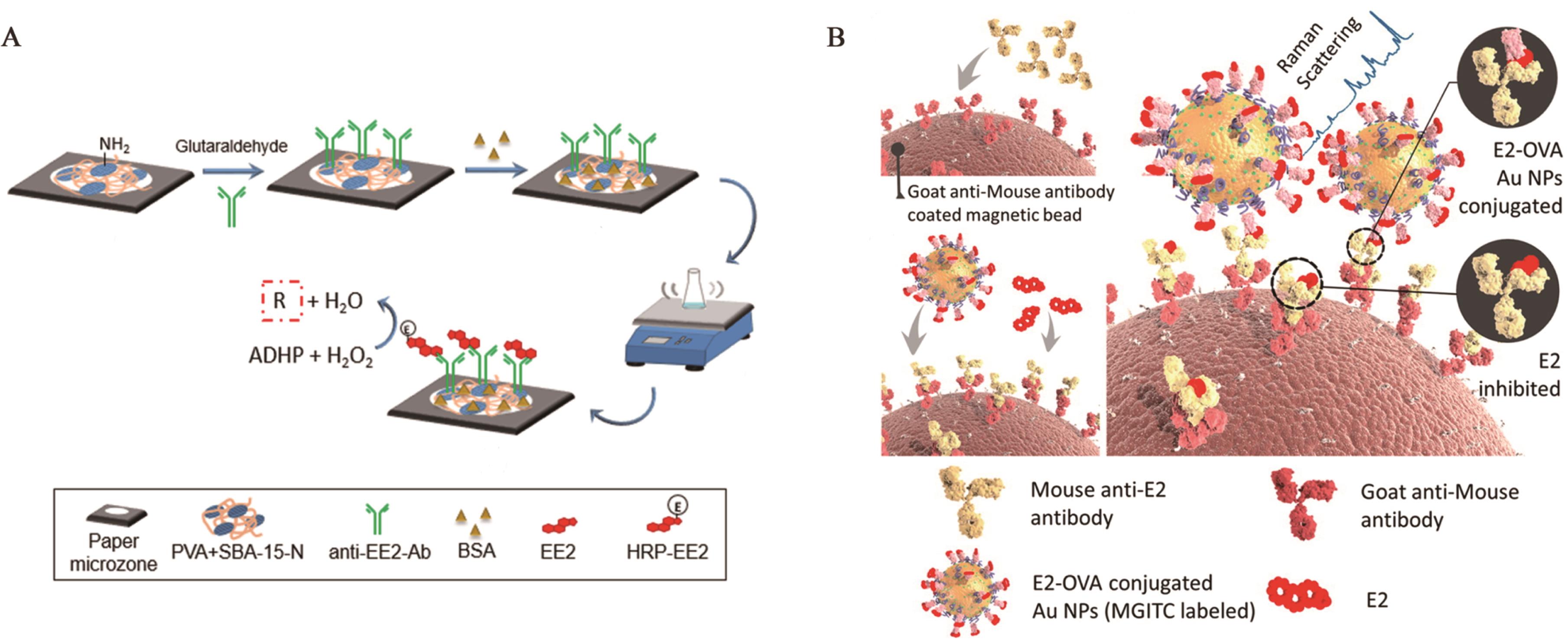
图6 基于抗体的光学生物传感器:(A)使用荧光纸基免疫传感器定量检测饮用水中E2的示意图[64];(B)基于SERS的竞争性免疫分析定量E2的示意图[68]
Fig.6 Antibody-based optical biosensor: (A)Schematic illustration of the estradiol quantification in drinking water sources using a fluorescent paper based immunosensor[64];(B)Schematic illustration of the SERS-based competitive immunoassay for quantification of E2[68]
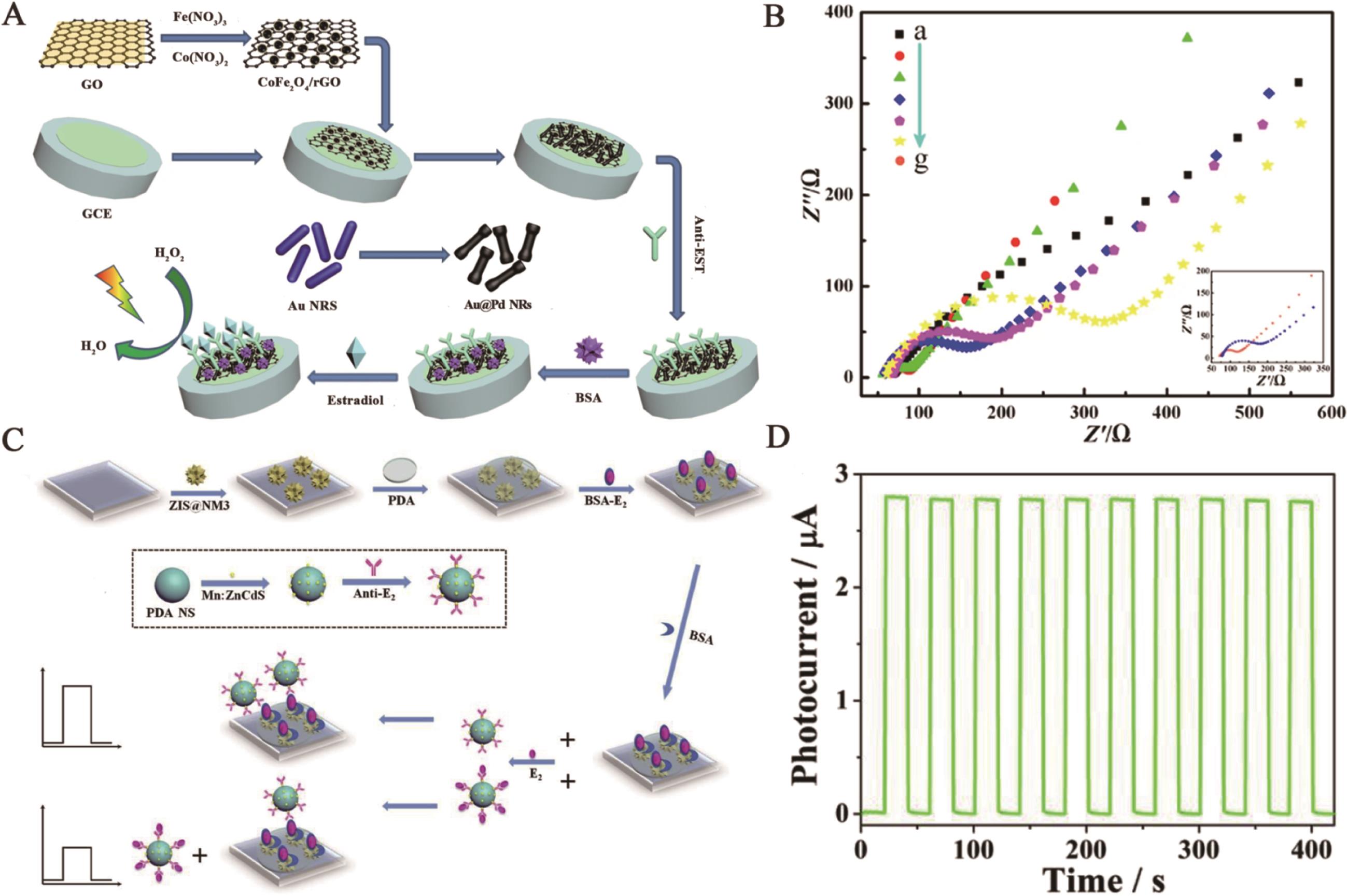
图7 基于抗体的电化学和光电化学生物传感器: (A)基于Au@Pd NRs与CoFe2O4/r GO增强信号放大的无标记电化学免疫传感器[74];(B) Au@Pd NRS与CoFe2O4/r GO增强信号的表征[74];(C) 基于PDA NS/Mn:ZnCdS和ZnIn2S4@NH2-MIL-125(Ti)信号放大的光电化学竞争免疫传感器[76];(D)在10个循环内检测0.1 ng/mL E2的传感器的稳定[76]
Fig.7 Antibody-based electrochemical and photoelectrochemical biosensors:(A)Label-free electrochemical immunosensor based on enhanced signal amplification between Au@Pd NRs and CoFe2O4/graphene nanohybrid[74];(B)Characterization of enhanced signal amplification between Au@Pd NRs and CoFe2O4/r GO;(C)Photoelectrochemical competitive immunosensor for 17β-estradiol detection based on ZnIn2S4@NH2-MIL-125(Ti) amplified by PDA NS/Mn:ZnCdS[76];(D)Stability of the sensor for the detection of 0.1 ng/mL E2 under for 10 cycles[76]
| 1 | ZHANG G, LI T, ZHANG J, et al. A simple FRET-based turn-on fluorescent aptasensor for 17β-estradiol determination in environmental water, urine and milk samples[J]. Sens Actuators B, 2018, 273: 1648-1653. |
| 2 | 马嘉琪, 姚晓琳, 刘思杰, 等. 基于不同探针免疫层析方法对17β-雌二醇的分析灵敏度比较研究[J]. 分析测试学报, 2021, 40(3): 310-317. |
| MA J Q, YAO X L, LIU S J, et al. Comparative study on the sensitivity of 17β-estradiol based on different probe immunochromatographic methods[J]. J Instrum Anal, 2021, 40(3): 310-317. | |
| 3 | 马丽莎, 戴晓欣, 谢文平, 等. QuEChERS/GC-MS法同时测定鱼、虾中的雌二醇与己烯雌酚残留[J]. 分析测试学报, 2015, 34(1): 62-66. |
| MA L S, DAI X X, XIE W P, et al. Simultaneous determination of diethylstilbestrol and estradiol in fish and shrimp by GC-MS with QuEChERS sample preparation[J]. J Instrum Anal, 2015, 34(1): 62-66. | |
| 4 | ZHANG Y, ZHOU J L, NING B. Photodegradation of estrone and 17β-estradiol in water[J]. Water Res, 2007, 41(1): 19-26. |
| 5 | NI X, XIA B, WANG L, et al. Fluorescent aptasensor for 17β-estradiol determination based on gold nanoparticles quenching the fluorescence of rhodamine B[J]. Anal Biochem, 2017, 523: 17-23. |
| 6 | 王全林, 张爱芝, 陈立仁. 超高效液相色谱-串联质谱法对奶制品中苯甲酸雌二醇残留的测定[J]. 分析测试学报, 2009, 28(9): 1069-1073. |
| WANG Q L, ZHANG A Z, CHEN L R. Determination of estradiol benzoate residues in dairy products by ultra performance liquid chromatography-tandem mass spectrometry[J]. J Instrum Anal, 2009, 28(9): 1069-1073. | |
| 7 | HINTEMAN T, SCHNEIDER C, SCHOLER H F, et al. Field study using two immunoassays for the determination of estradiol and ethinylestradiol in the aquatic environment[J]. Water Res, 2006, 40(12): 2287-94. |
| 8 | HAN D H, DENISON M S, TACHIBANA H, et al. Relationship between estrogen receptor-binding and estrogenic activities of environmental estrogens and suppression by flavonoids[J]. Biosci Biotechnol Biochem, 2002, 66(7): 1479-87. |
| 9 | GANMAA D, WANG P Y, QIN L Q, et al. Is milk responsible for male reproductive disorders?[J]. Med Hypotheses, 2001, 57(4): 510-514. |
| 10 | PAPE-ZAMBITOD A, ROBERTS R F, KENSINGER R S. Estrone and 17β-estradiol concentrations in pasteurized-homogenized milk and commercial dairy products[J]. J Dairy Sci, 2010, 93(6): 2533-2540. |
| 11 | JURGENS M D, HOLTHAUS K I E, JOHNSON A C, et al. The potential for estradiol and ethinylestradiol degradation in English rivers[J]. Environ Toxicol Chem, 2002, 21(3): 480-488. |
| 12 | QI X, HU H, YANG Y, et al. Graphite nanoparticle as nanoquencher for 17β-estradiol detection using shortened aptamer sequence [J]. Analyst, 2018, 143(17): 4163-4170. |
| 13 | MASIKINI M, GHICA M E, BAKER P G L, et al. Electrochemical sensor based on multi-walled carbon nanotube/gold nanoparticle modified glassy carbon electrode for detection of estradiol in environmental samples[J]. Electroanalysis, 2019, 31(10): 1925-1933. |
| 14 | LU H, XU S. Mesoporous structured estrone imprinted Fe3O4@SiO2@mSiO2 for highly sensitive and selective detection of estrogens from water samples by HPLC[J]. Talanta, 2015, 144: 303-311. |
| 15 | FARRE M, KUSTER M, BRIX R, et al. Comparative study of an estradiol enzyme-linked immunosorbent assay kit, liquid chromatography-tandem mass spectrometry, and ultra performance liquid chromatography-quadrupole time of flight mass spectrometry for part-per-trillion analysis of estrogens in water samples[J]. J Chromatogr A, 2007, 1160(1/2): 166-175. |
| 16 | CHOI M H, KIM K R, CHUNG B C. Determination of estrone and 17β-estradiol in human hair by gas chromatography-mass spectrometry[J]. Analyst, 2000, 125(4): 711-714. |
| 17 | SEIFERT M, HAINDL S, HOCK B. Development of an enzyme linked receptor assay (ELRA) for estrogens and xenoestrogens[J]. Anal Chim Acta, 1999, 386(3): 191-199. |
| 18 | NORTH S H, LOCK E H, TAITT C R, et al. Critical aspects of biointerface design and their impact on biosensor development[J]. Anal Bioanal Chem, 2010, 397(3): 925-933. |
| 19 | 付志强, 熊艳. 便携式生物光学传感器的研究进展[J]. 生物技术通报, 2021, 37(3): 219-226. |
| FU Z Q, XIONG Y. Research progress of portable bio-optical sensors[J]. Biotechnol Bull, 2021, 37(3): 219-226. | |
| 20 | NUNES DA SILVA D, LEIJOTO DE OLIVEIRA H, BORGES K B, et al. Sensitive determination of 17β-estradiol using a magneto sensor based on magnetic molecularly imprinted polymer[J]. Electroanalysis, 2020, 33(2): 506-514. |
| 21 | GUGOASA L A, STEFAN-VAN STADEN R I, CALENIC B, et al. Multimode sensors as new tools for molecular recognition of testosterone, dihydrotestosterone and estradiol in children's saliva[J]. J Mol Recognit, 2015, 28(1): 10-19. |
| 22 | WANG X, PEI K, SUN H, et al. A magnetic relaxation switch sensor for determination of 17β-Estradiol in milk and eggs based on aptamer-functionalized Fe3O4@Au nanoparticles[J/OL]. J Sci Food Agric, 2021, 101(13): 5697-5706. |
| 23 | PRASKOVIYA B, SVITLANA S, LUC V, et al. Self-tuning interfacial architecture for estradiol detection by surface plasmon resonance biosensor[J]. Biosens Bioelectron, 2017, 90: 91-95. |
| 24 | BRODY EN, GOLD L. Aptamers as therapeutic and diagnostic agents[J]. J Biotechnol, 2000, 74(1): 5-13. |
| 25 | 孙娜娜. 基于啶虫脒适配体和抗体的上转换荧光快速检测方法研究[D]. 南京: 南京农业大学, 2018. |
| SUN N N. Study on the up-conversion fluorescence rapid detection method based on acetamiprid aptamer and antibody[D]. Nanjing: Nanjing Agricultural University, 2018. | |
| 26 | WATTS H J, LOWE C R, POLLARD-KNIGHT D V. Optical biosensor for monitoring microbial cells[J]. Anal Chem, 1994, 66(15): 2465-2470. |
| 27 | SANTOS A, BALDERRAMA V S, ALBA M, et al. Nanoporous anodic alumina barcodes: toward smart optical biosensors[J]. Adv Mater, 2012, 24(8): 1050-1054. |
| 28 | 徐林. 基于信号放大的荧光生物传感器用于生物小分子的高灵敏检测[D]. 重庆: 重庆理工大学, 2020. |
| XU L. Fluorescence biosensor based on signal amplification is used for highly sensitive detection of small biological molecules[D]. Chongqing: Chongqing University of Technology, 2020. | |
| 29 | BAHREYNI A, LUO H, RAMEZANI M, et al. A fluorescent sensing strategy for ultrasensitive detection of oxytetracycline in milk based on aptamer-magnetic bead conjugate, complementary strand of aptamer and PicoGreen[J]. Spectrochim Acta A, 2021, 246: 119009. |
| 30 | 董亚非, 胡文晓, 钱梦瑶, 等. 基于DNA适应体的荧光生物传感器[J]. 电子与信息学报, 2020, 42(6): 75-83. |
| DONG Y F, HU W X, QIAN M Y, et al. Fluorescence biosensor based on DNA adaptor[J]. J Electr Inf Technol, 2020, 42(6): 75-83. | |
| 31 | HU L, CHENG Q, CHEN D, et al. Liquid-phase exfoliated graphene as highly-sensitive sensor for simultaneous determination of endocrine disruptors: diethylstilbestrol and estradiol[J]. J Hazard Mater, 2015, 283: 157-163. |
| 32 | WANG Y, ZHAO X, ZHANG M, et al. A fluorescent amplification strategy for high-sensitive detection of 17β-estradiol based on EXPAR and HCR[J]. Anal Chim Acta, 2020, 1116: 1-8. |
| 33 | HUANG H, SHI S, GAO X, et al. A universal label-free fluorescent aptasensor based on Ru complex and quantum dots for adenosine, dopamine and 17β-estradiol detection[J]. Biosens Bioelectron, 2016, 79: 198-204. |
| 34 | JAZAYERI M H, AGHAIE T, AVAN A, et al. Colorimetric detection based on gold nano particles (GNPs): an easy, fast, inexpensive, low-cost and short time method in detection of analytes (protein, DNA, and ion)[J]. Sensing Bio-Sensing Res, 2018, 20: 1-8. |
| 35 | 王燕, 周化岚, 施沁怡, 等. 基于金纳米粒子光学性质的比色传感器及其在食品安全检测中的应用[J]. 理化检验(化学分册), 2019, 55(12): 1476-1482. |
| WANG Y, ZHOU H L, SHI Q Y, et al. Colorimetric sensor based on optical properties of gold nanoparticles and its application in food safety detection[J]. Phys Chem Ins (Chem Sect), 2019, 55(12): 1476-1482. | |
| 36 | JALALIAN S H, LAVAEE P, RAMEZANI M, et al. An optical aptasensor for aflatoxin M1 detection based on target-induced protection of gold nanoparticles against salt-induced aggregation and silica nanoparticles[J]. Spectrochim Acta A, 2021, 246. |
| 37 | 王欣. 基于核酸适配体的牛奶和鸡蛋中雌二醇纳米金比色检测[J]. 农业机械学报, 2019, 2020, 51(9): 319-328. |
| WANG X. Nucleic acid aptamer-based colorimetric detection of estradiol nanogold in milk and eggs[J]. Trans Chinese Soc Agric Mach, 2020, 51(9): 319-328. | |
| 38 | LI Y, XU J, JIA M, et al. Colorimetric determination of 17β-estradiol based on the specific recognition of aptamer and the salt-induced aggregation of gold nanoparticles[J]. Mater Lett, 2015, 159: 221-224. |
| 39 | ZHANG D, ZHANG W, YE J, et al. A Label-free colorimetric biosensor for 17β-estradiol detection using nanoparticles assembled by aptamer and cationic polymer[J]. Aust J Chem, 2016, 69(1): 12-19. |
| 40 | 黄磊, 王欣, 刘厦, 等. 基于适配体的生物传感器在双酚A检测中的应用[J]. 分析化学, 2021, 49(2): 172-183. |
| HUANG L, WANG X, LIU S, et al. Application of aptamer-based biosensor in the detection of bisphenol A[J]. Chinese J Anal Chem, 2021, 49(2): 172-183. | |
| 41 | 王海旺. 基于目标物介导SERS金纳米颗粒自组装的新型生物传感器研究[D]. 济南大学, 2019. |
| WANG H W. Research on a novel biosensor based on target mediated self-assembly of SERS gold nanoparticles[D]. Universty of Jinan, 2019. | |
| 42 | GANDRA N, ABBAS A, TIAN L, et al. Plasmonic planet-satellite analogues: hierarchical self-assembly of gold nanostructures[J]. Nano Lett, 2012, 12(5): 2645-2651. |
| 43 | SIYAO L, YUQING C, YING W, et al. Group-targeting detection of total steroid estrogen using surface-enhanced raman spectroscopy[J]. Anal Chem, 2019, 91(12): 7639-7647. |
| 44 | 谢晓慧. 适配体修饰核壳纳米材料表面增强拉曼光谱检测17β-雌二醇方法研究[D]. 华南理工大学, 2018. |
| XIE X H. Aptamer-modified core-shell nanomaterials surface enhanced Raman spectroscopy method for the detection of 17β-estradiol[D]. South China University of Technology, 2018. | |
| 45 | 姚武, 崔朋, 胡晓倩. 基于信号增强的电化学发光适配体传感器检测三磷酸腺苷[J]. 发光学报, 2020, 41(6): 117-125. |
| YAO W, CUI P, HU X Q. Electrochemiluminescence aptamer sensor based on signal enhancement for the detection of adenosine triphosphate[J].Chinese J Lumin, 2020, 41(6): 117-125. | |
| 46 | ZHAO G, WANG Y, LI X, et al. Dual-Quenching electrochemiluminescence strategy based on three-dimensional metal-organic frameworks for ultrasensitive detection of amyloid-beta[J]. Anal Chem, 2019, 91(3): 1989-1996. |
| 47 | XU Y, LIU J, GAO C, et al. Applications of carbon quantum dots in electrochemiluminescence: a mini review[J]. Electrochem Commun, 2014, 48: 151-154. |
| 48 | KIRSCHBAUM S E, BAEUMNER A J. A review of electrochemiluminescence (ECL) in and for microfluidic analytical devices [J]. Anal Bioanal Chem, 2015, 407(14): 3911-3926. |
| 49 | ZHANG J J, CAO J T, SHI G F, et al. Label-free and sensitive electrochemiluminescence aptasensor for the determination of 17β-estradiol based on a competitive assay with cDNA amplification[J]. Anal Methods, 2014, 6(17): 6796-6801. |
| 50 | LIU Y, LI B, YAO Y, et al. An electrochemiluminescence sensor for 17β-estradiol detection based on resonance energy transfer in alpha-FeOOH@CdS/Ag NCs[J]. Talanta, 2021, 221: 121479. |
| 51 | 邓昆. 非标记型电化学适配体传感器的构建及其在蛋白质检测中的应用[D]. 第三军医大学, 2013. |
| DENG K. Construction of a non-labeled electrochemical aptamer sensor and its application in protein detection[D]. Third Military Medical University, 2013. | |
| 52 | 李凤琴, 俞志刚, 韩贤达, 等. 检测牛奶和水中卡那霉素残留物的电化学适配体传感器研究进展[J]. 分析科学学报, 2019, 35(4): 514-520. |
| LI F Q, YU Z G, HAN X D, et al. Research progress of electrochemical aptamer sensors for detecting kanamycin residues in milk and water[J]. J Anal Sci, 2019, 35(4): 514-520. | |
| 53 | ZHAO L, YANG K, HUANG W, et al. Electrochemical biosensors based on two dimensional nano-materials for disease diagnosis[J]. Chinese Sci Bull, 2016, 61(11): 1222-1232. |
| 54 | LIN X, NI Y, KOKOT S. Electrochemical cholesterol sensor based on cholesterol oxidase and MoS2-AuNPs modified glassy carbon electrode[J]. Sens Actuators B: Chem, 2016, 233: 100-106. |
| 55 | 贺彩梅, 郑景伊, 李晓霞. 基于二硫化钼/纳米金和硫堇/纳米信号放大的雌二醇电化学适配体传感器[J]. 高等学校化学学报, 2019, 40(10): 2090-2096. |
| HE C M, ZHENG J Y, LI X X. Estradiol electrochemical aptamer sensor based on molybdenum disulfide/nano gold and thionine/nano signal amplification[J]. Chem J Chinese Univ, 2019, 40(10): 2090-2096. | |
| 56 | LIU M, KE H, SUN C, et al. A simple and highly selective electrochemical label-free aptasensor of 17β-estradiol based on signal amplification of bi-functional graphene[J]. Talanta, 2019, 194: 266-272. |
| 57 | MATTEA CARMEN C, PAOLA B, JACOPO C, et al. Electrospray deposition as a smart technique for laccase immobilisation on carbon black-nanomodified screen-printed electrodes[J]. Biosens Bioelectron, 2020, 163: 112299. |
| 58 | 蓝庆春. 新型无标记电化学免疫传感器的构建及其在肿瘤标志物检测中的应用[D]. 扬州大学, 2020. |
| LAN Q C. Construction of a new label-free electrochemical immunosensor and its application in the detection of tumor markers[D]. Yangzhou University, 2020. | |
| 59 | 聂荣彬. 新型化学发光免疫传感器的构建与应用[D]. 东北师范大学, 2020. |
| NIE R B. Construction and application of a new type of chemiluminescence immunosensor[D]. Northeast Normal University, 2020. | |
| 60 | 郝一雄, 郭金虎. 纳米材料在生物免疫传感器中应用的研究进展[J]. 同济大学学报(医学版), 2020, 41(4): 131-137. |
| HAO Y X,GUO J H. Research progress in the application of nanomaterials in biological immunosensors[J]. J Tongji Univ Med Sci, 2020, 41(4): 131-137. | |
| 61 | 孙艳, 孙锋, 杨玉孝, 等. 光学免疫传感器技术与应用[J]. 仪表技术与传感器, 2002 (7): 5-8. |
| SYN Y, SUN F, YANG Y X, et al. Optical immunosensor technology and application[J]. Instrum Technol Sens, 2002(7): 5-8. | |
| 62 | KIM H R, KIM J H, KIM T S, et al. Optical detection of deoxyribonucleic acid hybridization using an anchoring transition of liquid crystal alignment[J]. Appl Phys Lett, 2005, 87(14): 105. |
| 63 | 单迪迪, 文晓刚, 刘兰华, 等. 基于阵列倏逝波荧光传感器的雌二醇免疫检测方法[J]. 光谱学与光谱分析, 2018, 38(10): 3148-3251. |
| SHAN D D, WEN X G, LIU L H, et al. Estradiol immunodetection method based on array evanescent wave fluorescence sensor[J].Spectrosc Spectr Anal, 2018, 38(10): 3148-3251. | |
| 64 | SCALA-BENUZZI M L, TAKARA E A, ALDERETE M, et al. Ethinylestradiol quantification in drinking water sources using a fluorescent paper based immunosensor[J]. Microchem J, 2018, 141: 287-293. |
| 65 | FUNARI R, DELLA VENTURA B, ALTUCCI C, et al. Single molecule characterization of UV-activated antibodies on gold by atomic force microscopy[J]. Langmuir, 2016, 32(32): 8084-8091. |
| 66 | MINOPOLI A, SAKAČ N, LENYK B, et al. LSPR-based colorimetric immunosensor for rapid and sensitive 17β-estradiol detection in tap water[J]. Sens Actuators B: Chem, 2020, 308: 127699. |
| 67 | 刘小红, 邓华, 常林, 等. 环境雌激素SERS检测的研究进展[J]. 光谱学与光谱分析, 2020, 40(10): 3038-3047. |
| LIU X H, DENG H, CHANG L, et al. Research progress of environmental estrogen SERS detection[J]. Spectrosc Spectr Anal,2020, 40(10): 3038-3047. | |
| 68 | WANG R, CHON H, LEE S, et al. Highly sensitive detection of hormone estradiol E2 using surface-enhanced raman scattering based immunoassays for the clinical diagnosis of precocious puberty[J]. ACS Appl Mater Interfaces, 2016, 8(17): 10665-72. |
| 69 | 李如男, 郭兴道, 陈文杨, 等. 女性关键生育力评价指标雌二醇、抗苗勒管激素及窦卵泡数目的拉曼光谱检测[J]. 第二军医大学学报, 2019, 363(11): 61-68. |
| LI R N, GUO X D, CHEN W Y, et al. Raman spectroscopy detection of estradiol, anti-Müllerian hormone and the number of antral follicles, the key indicators of female fertility evaluation[J]. J Second Mil Med Univ, 2019, 363(11): 61-68. | |
| 70 | HE S, XIE W, ZHANG W, et al. Multivariate qualitative analysis of banned additives in food safety using surface enhanced Raman scattering spectroscopy[J]. Spectrochim Acta A: Mol Biomol Spectrosc, 2015, 137: 1092-1099. |
| 71 | 白家磊. 典型激素类污染物检测的双通道ICA与ECL-RET传感技术研究[D]. 中国人民解放军军事医学科学院, 2016. |
| BAI J L. Research on dual-channel ICA and ECL-RET sensing technology for the detection of typical hormone pollutants[D]. Chin Acad Mil Med Sci, 2016. | |
| 72 | 胡梅. 抗球虫药单克隆抗体的制备及其在电化学免疫传感器中的应用[D]. 江南大学, 2019. |
| HU M. Preparation of anticoccidial monoclonal antibody and its application in electrochemical immunosensor[D]. Jiangnan University, 2019. | |
| 73 | ZHANG X, LI Y, LV H, et al. Sandwich-type electrochemical immunosensor based on Au@Ag supported on functionalized phenolic resin microporous carbon spheres for ultrasensitive analysis of alpha-fetoprotein[J]. Biosens Bioelectron, 2018, 106: 142-148. |
| 74 | ZHANG Y, LI J, WANG Z, et al. Label-free electrochemical immunosensor based on enhanced signal amplification between Au@Pd and CoFe2O4/graphene nanohybrid[J]. Sci Rep, 2016, 6: 23391. |
| 75 | SEN Z, BIN D, HE L, et al. Metal ions-based immunosensor for simultaneous determination of estradiol and diethylstilbestrol[J]. Biosens Bioelectron, 2014, 52: 225-231. |
| 76 | YAN T, WU T, WEI S, et al. Photoelectrochemical competitive immunosensor for 17β-estradiol detection based on ZnIn2S4@NH2-MIL-125(Ti) amplified by PDA NS/Mn:ZnCdS[J]. Biosens Bioelectron, 2020, 148:111739. |
| 77 | LI R X, LIU Y X, YAN T, et al. A competitive photoelectrochemical assay for estradiol based on in situ generated CdS-enhanced TiO2[J]. Biosens Bioelectron, 2015, 66: 596-602. |
| [1] | 张雅静, 王晓辉, 徐亚娟, 刘文书, 赵丽辉. 石墨烯纳米载药体系的制备及对肿瘤细胞的杀伤作用[J]. 应用化学, 2021, 38(6): 693-703. |
| [2] | 张宇辉, 邢立刚, 程家维, 杨季冬. 共振瑞利散射法对普萘洛尔特效适配体系的手性分析[J]. 应用化学, 2020, 37(3): 359-366. |
| [3] | 黄雪雯, 许升, 赵伟, 魏玮, 李小杰, 刘晓亚. 聚合物纳米组装体修饰丝网印刷电极构建过氧化氢传感器[J]. 应用化学, 2020, 37(2): 235-241. |
| [4] | 莫艳红, 李晖, 王彬, 徐晓慧, 刘思思, 曾冬冬. 血红素/G-四链体DNA酶的活性增强研究及其在生物传感器中的应用进展[J]. 应用化学, 2020, 37(11): 1249-1261. |
| [5] | 古鑫宇, 郎乐, 王建伟, 赵丽辉. 基于磁珠-适配体的高效液相色谱-串联质谱法检测食品中的黄曲霉毒素B1[J]. 应用化学, 2020, 37(11): 1324-1332. |
| [6] | 韦国兵,孔德荣,徐慧慧,殷赵江,张晶,崔汉峰,洪年,杨婕,熊魏,刘文明,郭倩文,程林,樊浩. 基于主客体识别作用构建的电化学发光传感器检测丹参中汞离子[J]. 应用化学, 2019, 36(5): 595-602. |
| [7] | 覃晓丽,王茗涵,董逸帆,邵元华. 电化学发光生物传感技术在快速检测心肌梗死标志物中的研究进展[J]. 应用化学, 2018, 35(9): 1107-1112. |
| [8] | 黄子珂, 刘超, 付强强, 李进, 邹建梅, 谢斯滔, 邱丽萍. 核酸适配体荧光探针在生化分析和生物成像中的研究进展[J]. 应用化学, 2018, 35(1): 28-39. |
| [9] | 李辉彦, 白效静, 王风红, 李静, 唐纪琳. 基于微悬臂梁生物传感器检测三磷酸腺苷[J]. 应用化学, 2015, 32(3): 362-366. |
| [10] | 杨绍明, 查文玲, 孙清, 李红, 李瑞琴, 尚培玲. 基于铁氰化镍的非标记型核酸适配体电化学传感器检测凝血酶[J]. 应用化学, 2014, 31(06): 742-748. |
| [11] | 屈枫锦, 陈芳, 侯秀璋, 马晓燕. 二茂铁及其衍生物在传感器上的应用进展[J]. 应用化学, 2013, 30(12): 1393-1398. |
| [12] | 杨绍明, 查文玲, 李红, 孙清, 刘斌, 郑龙珍. 半胱氨酸封闭剂为电化学探针的非标记型核酸适配体传感器[J]. 应用化学, 2013, 30(05): 549-554. |
| [13] | 安玲玲, 常颖萃, 杜江燕. 三维有序石墨烯掺杂纳米二氧化钛酶生物传感器[J]. 应用化学, 2013, 30(02): 171-177. |
| [14] | 吴玉芹, 陈金龙. 水溶性发光金量子点灵敏检测L-半胱氨酸[J]. 应用化学, 2013, 30(02): 225-231. |
| [15] | 杨秀云, 梁凤, 张巍, 胡连哲, Majeed Saadat, 李云辉, 徐国宝. 葡萄糖生物传感器检测方法的研究进展[J]. 应用化学, 2012, 29(12): 1364-1370. |
| 阅读次数 | ||||||
|
全文 |
|
|||||
|
摘要 |
|
|||||